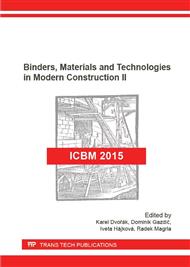p.87
p.95
p.107
p.114
p.120
p.126
p.130
p.135
p.141
Possibilities of Using Recycled Concrete and Silica Binders for Development of Sound Absorbing Concrete
Abstract:
With development and reconstruction of traffic routes there has recently been an increased need for noise reduction measures, out of which the most effective one appears to be the construction of noise barriers that prevent sound propagation from its source and (in case of sound absorbing barriers) absorb sound and thus reduce the noise load near the sound source (around a traffic route). The manufacturing of noise barriers often enables the use of secondary raw materials and thus to reduce the energy and material costs of their production as well as decrease the environmental impact. An interesting option is the use of recycled concrete that is suitable for production of concrete with open structure to be used in the absorber layer of a sound barrier and can even be used in the structural layer as well. The paper describes the possibilities of using recycled concrete in the production of sound absorbing barriers with a high degree of sound absorption.
Info:
Periodical:
Pages:
120-125
Citation:
Online since:
August 2016
Authors:
Price:
Сopyright:
© 2016 Trans Tech Publications Ltd. All Rights Reserved
Share:
Citation:


